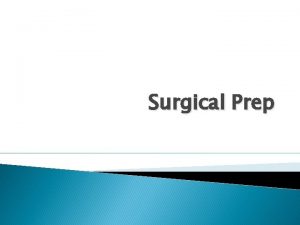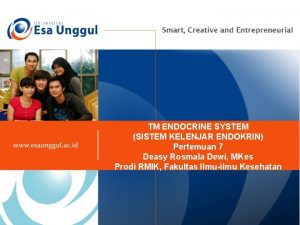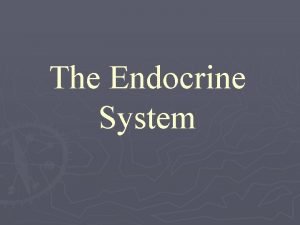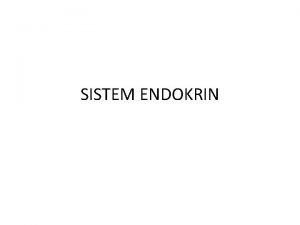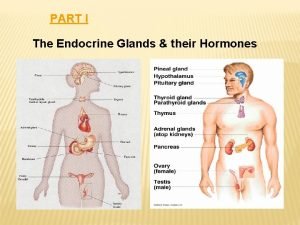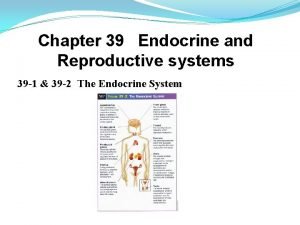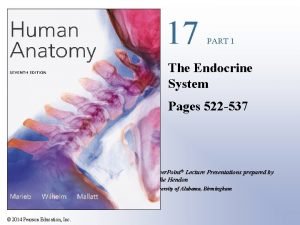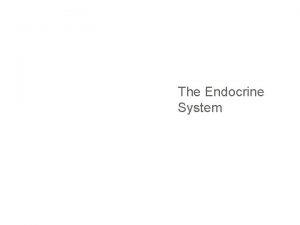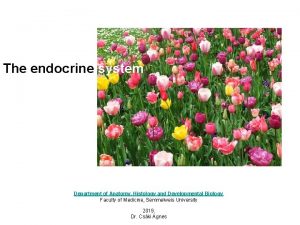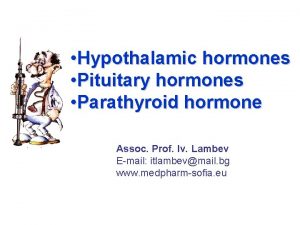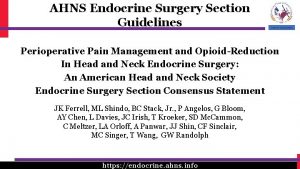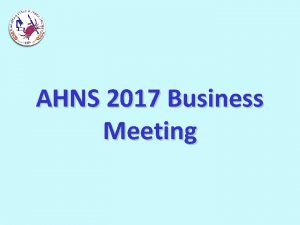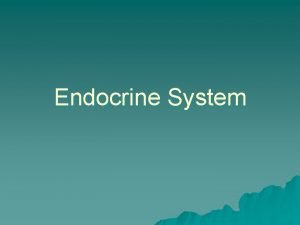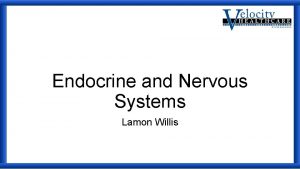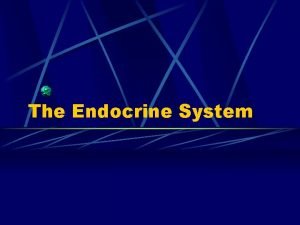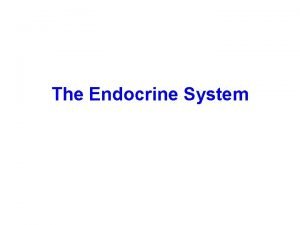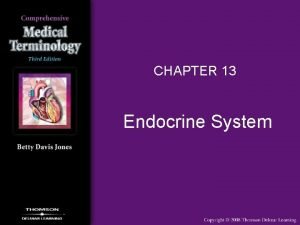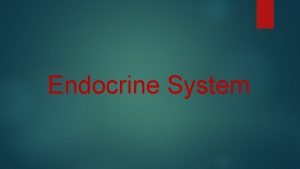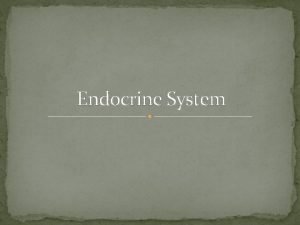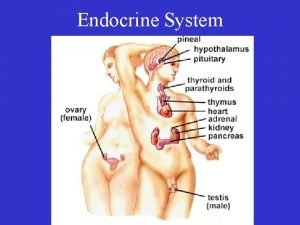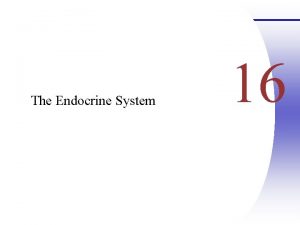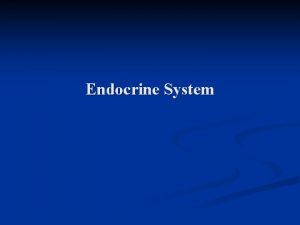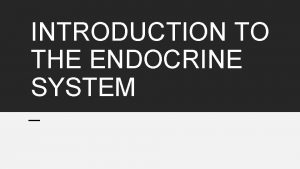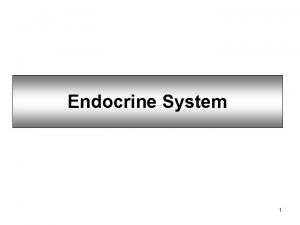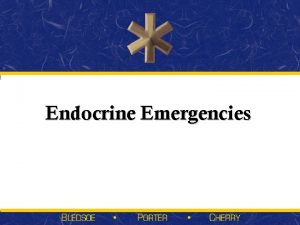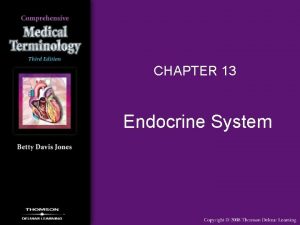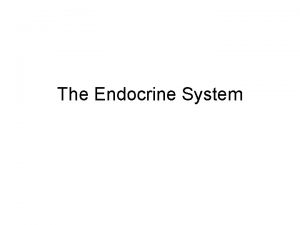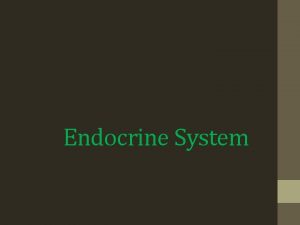AHNS Endocrine Surgery Section Guidelines Surgical Management of
































- Slides: 32

AHNS Endocrine Surgery Section Guidelines Surgical Management of the Recurrent Laryngeal Nerve in Thyroidectomy C. Fundakowski, N. Hales, N. Agrawal, M. Barcynski, P. Camacho, D. Hartl, E. Kandil, W. Liddy, T. Mc. Kenzie, J. Morris, J. Ridge, R. Schneider, J. Serpell, C. Sinclair, S. Snyder, D. Terris, R. Tuttle, CW. Wu, R. Wong, M. Zafereo, G. Randolph https: //endocrine. ahns. info

AHNS Endocrine Surgery Section - https: //endocrine. ahns. info

Consensus Development • Consensus Author Panel • International, multidisciplinary effort • Members of AHNS Endocrine Surgery Section, endocrinologists, endocrine surgeons, head & neck surgeons • Recommendations • Authors with expertise for respective sections • Evidence based literature - thyroid surgical publications & recent AAO-HNS, AHNS & ATA guidelines AHNS Endocrine Surgery Section - https: //endocrine. ahns. info

Surgical Management of the Recurrent Laryngeal Nerve in Thyroidectomy • Intention: To help guide surgeons in clinical decision making for intraoperative RLN management, particularly in the setting of thyroid cancer • Statement includes discussion of: • • • Details of RLN embryology & anatomy Surgical approaches to RLN Advances in RLN monitoring Management of RLN invaded by malignancy Concept of staged surgery Implications for radioactive iodine AHNS Endocrine Surgery Section - https: //endocrine. ahns. info

Background • Post-thyroidectomy voice complaints - 30 -87% • Rates of RLN injury reported to be - 3 -5% • True incidence significantly underestimates - closer to 10% • Risk factors for RLN injury during thyroidectomy: • • • Revision procedures Malignancy, Graves’ disease Recurrent or substernal goiter Hematoma exploration Surgeon volume AHNS Endocrine Surgery Section - https: //endocrine. ahns. info

Background • Unilateral • Dyspnea • Dysphonia (hoarseness, vocal fatigue, breathy voice) • Dysphagia with potential aspiration. • Bilateral • Stridor • Respiratory distress • Airway compromise due to obstruction AHNS Endocrine Surgery Section - https: //endocrine. ahns. info

Recommendation 2. 1 • Comprehensive understanding of the embryology and anatomy of the RLN, larynx, and neck base is essential for optimal management of the RLN during thyroidectomy AHNS Endocrine Surgery Section - https: //endocrine. ahns. info

RLN Embryology • Thyroid - fusion of the medial thyroid anlage (derived from the primitive pharynx) & the lateral thyroid anlage (derived from the neural crest) • Tubercle of Zuckerkandl - a posterior lateral projection from the thyroid, represents this site of fusion • Superior parathyroid gland - originates from the 4 th branchial pouch • RLN - arises from the vagus nerve • Carries motor, sensory, parasympathetic fibers AHNS Endocrine Surgery Section - https: //endocrine. ahns. info

Anatomy of the RLN • Right RLN • Loops around right subclavian artery • Ascends in more anterior, oblique and lateral path • Left RLN • Loops around aortic arch • Ascends more vertically & deeper in left tracheoesophageal groove. • Both nerves • Cross inferior thyroid artery • Enter larynx below cricothyroid joint just under inferior constrictor muscles AHNS Endocrine Surgery Section - https: //endocrine. ahns. info

Anatomy of the RLN AHNS Endocrine Surgery Section - https: //endocrine. ahns. info

Anatomy of the RLN AHNS Endocrine Surgery Section - https: //endocrine. ahns. info

Non-recurrent Laryngeal Nerve • Direct medial course from vagus nerve • Usually at level of inferior thyroid artery • Ascends in tracheoesophageal groove • Usually occur on right side • Estimated incidence 0. 5 -1% AHNS Endocrine Surgery Section - https: //endocrine. ahns. info

Recommendation 2. 2 • Knowledge of the anatomically complex Ligament of Berry is essential for safe thyroid and parathyroid surgery AHNS Endocrine Surgery Section - https: //endocrine. ahns. info

Ligament of Berry • Ligament of Berry is the most common site of RLN injury “I have noticed in operations of this kind, which I have seen performed by others upon the living, and in a number of excisions, which I have myself performed on the dead body, that most of the difficulty in the separation of the tumor has occurred in the region of these ligaments. . This difficulty, I believe, to be a very frequent source of that accident, which so commonly occurs in removal of goiter, I mean division of the recurrent laryngeal nerve. ” -Sir James Berry, 1887 AHNS Endocrine Surgery Section - https: //endocrine. ahns. info

Ligament of Berry - Anatomy • At the distal 2 cm of its extra-laryngeal course the RLN is intimately related to the Ligament of Berry. AHNS Endocrine Surgery Section - https: //endocrine. ahns. info

Recommendation 2. 3 • Surgeons should be familiar and adept at applying the four surgical approaches to the recurrent laryngeal nerve (lateral, inferior, superior, and medial) AHNS Endocrine Surgery Section - https: //endocrine. ahns. info

Approaches to RLN • Inferior approach more useful in revision cases • Superior approach for large goiters AHNS Endocrine Surgery Section - https: //endocrine. ahns. info

Approaches to RLN • Lateral approach - most common approach • Medial approach - may be useful in large goiters & in cases with small incisions AHNS Endocrine Surgery Section - https: //endocrine. ahns. info

Recommendation 2. 4 • Instruments/technology/intraoperative nerve monitoring - loss of signal AHNS Endocrine Surgery Section - https: //endocrine. ahns. info

Recommendation 2. 4 • Physiology of IONM electromyographic (EMG) data from thyroarytenoid/vocalis muscle • Current IONM options: • Intermittent IONM (I-IONM) • Handheld probe • Continuous IONM (C-IONM) • Temporary implantable vagus electrode AHNS Endocrine Surgery Section - https: //endocrine. ahns. info

Recommendation 2. 5 • Intraoperative neural monitoring can provide more information than sight alone during thyroidectomy AHNS Endocrine Surgery Section - https: //endocrine. ahns. info

Value of IONM • IONM provides: 1) Neural mapping information before nerve visualization 2) Prognostic information about nerve function 3) Information about site of nerve injury 4) Improved management of SLN 5) Information regarding possible duration of subsequent vocal cord paralysis AHNS Endocrine Surgery Section - https: //endocrine. ahns. info

Value of IONM • Intermittent IONM allows early detection & elucidation of mechanism of RLN injury • Learn and plan better intraoperative and postoperative management • Continuous IONM (C-IONM) permits real time monitoring of vagal & RLN functional integrity • May identify EMG signals associated with early-impending injury • Surgeon alerted to stop a maneuver causing stretching or compression of RLN • Better recovery of nerve function AHNS Endocrine Surgery Section - https: //endocrine. ahns. info

Recommendation 2. 6 • Optimal management of the recurrent laryngeal nerve that is adherent to or invaded by cancer requires knowledge of preoperative glottic function through preoperative laryngeal examination as well as intraoperative monitoring electromyography signal AHNS Endocrine Surgery Section - https: //endocrine. ahns. info

RLN Invasion • Superficial epineural invasion: • Shave or partial nerve sheath excision can allow for macroscopically clean margins with a functionally intact RLN • More extensive invasion: • Preoperative VCP: RLN resection recommended • Functional status determined by: 1) Preoperative laryngeal exam 2) Intraoperative EMG signal AHNS Endocrine Surgery Section - https: //endocrine. ahns. info

RLN Invasion • Invaded functioning RLN: • Attempt neural preservation • No survival benefit with complete resection VS small remnant & adjuvant Rx • Complete resection considered in selected cases of expected improvement in disease-free or overall survival AHNS Endocrine Surgery Section - https: //endocrine. ahns. info

Recommendation 2. 7 • In cases of loss of signal without electromyography recovery, the surgeon should consider staging the contralateral procedure to limit risk of bilateral cord paralysis and tracheotomy AHNS Endocrine Surgery Section - https: //endocrine. ahns. info

Recommendation 2. 7 • Possible false positive LOS or concern for complete cancer resection should be weighed against risk of bilateral VCP • Completion surgery performed: 1) When vocal fold mobility recovers postoperatively 2) Based on multidisciplinary discussion & patient counseling AHNS Endocrine Surgery Section - https: //endocrine. ahns. info

Recommendation 2. 8 • Management of the recurrent laryngeal nerve and Ligament of Berry intraoperatively have substantial implications for postoperative radioactive iodine thyroid bed scintillographic uptake and, therefore, significant implications for endocrinologists AHNS Endocrine Surgery Section - https: //endocrine. ahns. info

Postoperative Radioactive Iodine • Even with meticulous total thyroidectomy high resolution postoperative RAI scan detect small foci of uptake • Identifiable areas of uptake often seen on SPECTCT after total thyroidectomy commonly occur in areas closely related to the RLN AHNS Endocrine Surgery Section - https: //endocrine. ahns. info

Conclusion • RLN & EBSLN injury is often preventable with a thorough understanding of: • The embryology & anatomy of the RLN, Ligament of Berry & tubercle of Zuckerkandl • Surgical experience • An understanding of IONM • Safe & thorough thyroidectomy can be reliably performed with proper technique and knowledge • Multidisciplinary (endocrinology & surgery) approach can provide the highest surgical/oncological outcomes AHNS Endocrine Surgery Section - https: //endocrine. ahns. info

AHNS Endocrine Surgery Section Guidelines Surgical Management of the Recurrent Laryngeal Nerve in Thyroidectomy C. Fundakowski, N. Hales, N. Agrawal, M. Barcynski, P. Camacho, D. Hartl, E. Kandil, W. Liddy, T. Mc. Kenzie, J. Morris, J. Ridge, R. Schneider, J. Serpell, C. Sinclair, S. Snyder, D. Terris, R. Tuttle, CW. Wu, R. Wong, M. Zafereo, G. Randolph https: //endocrine. ahns. info
 Surgical prep
Surgical prep Unit 3 lesson 3 guidelines for eating
Unit 3 lesson 3 guidelines for eating Terminologi medis sistem endokrin
Terminologi medis sistem endokrin Major endocrine glands male and female
Major endocrine glands male and female Chapter 16 matching questions 20-24
Chapter 16 matching questions 20-24 Endocrine system and reproductive system
Endocrine system and reproductive system Mekanisme kerja master gland contohnya
Mekanisme kerja master gland contohnya Parts of the endocrine system
Parts of the endocrine system Endocrine system and nervous system
Endocrine system and nervous system Mechanisms of hypothalamic control over endocrine function
Mechanisms of hypothalamic control over endocrine function The body's speedy electrochemical communication network
The body's speedy electrochemical communication network Endocrine anatomy
Endocrine anatomy Comparison of endocrine and nervous system
Comparison of endocrine and nervous system Endocrine molecules
Endocrine molecules Endocrine system fact
Endocrine system fact Difference between endocrine and exocrine glands
Difference between endocrine and exocrine glands Lympathic
Lympathic Rat internal organs
Rat internal organs Chapter 46 digestive and endocrine disorders
Chapter 46 digestive and endocrine disorders Oxication
Oxication Section 39-4 fertilization and development
Section 39-4 fertilization and development Chapter 29 endocrine and metabolic disorders
Chapter 29 endocrine and metabolic disorders Chapter 19 endocrine and hematologic emergencies
Chapter 19 endocrine and hematologic emergencies Humoral neural and hormonal stimuli
Humoral neural and hormonal stimuli Are endocrine glands ductless
Are endocrine glands ductless 7:13 endocrine system
7:13 endocrine system Stimulus endocrine system
Stimulus endocrine system Lamina propria of tongue
Lamina propria of tongue Figure of endocrine system
Figure of endocrine system Pituitary gland inferior view
Pituitary gland inferior view Endocrine axis
Endocrine axis Hypothalamus
Hypothalamus General mechanism of hormone action
General mechanism of hormone action
